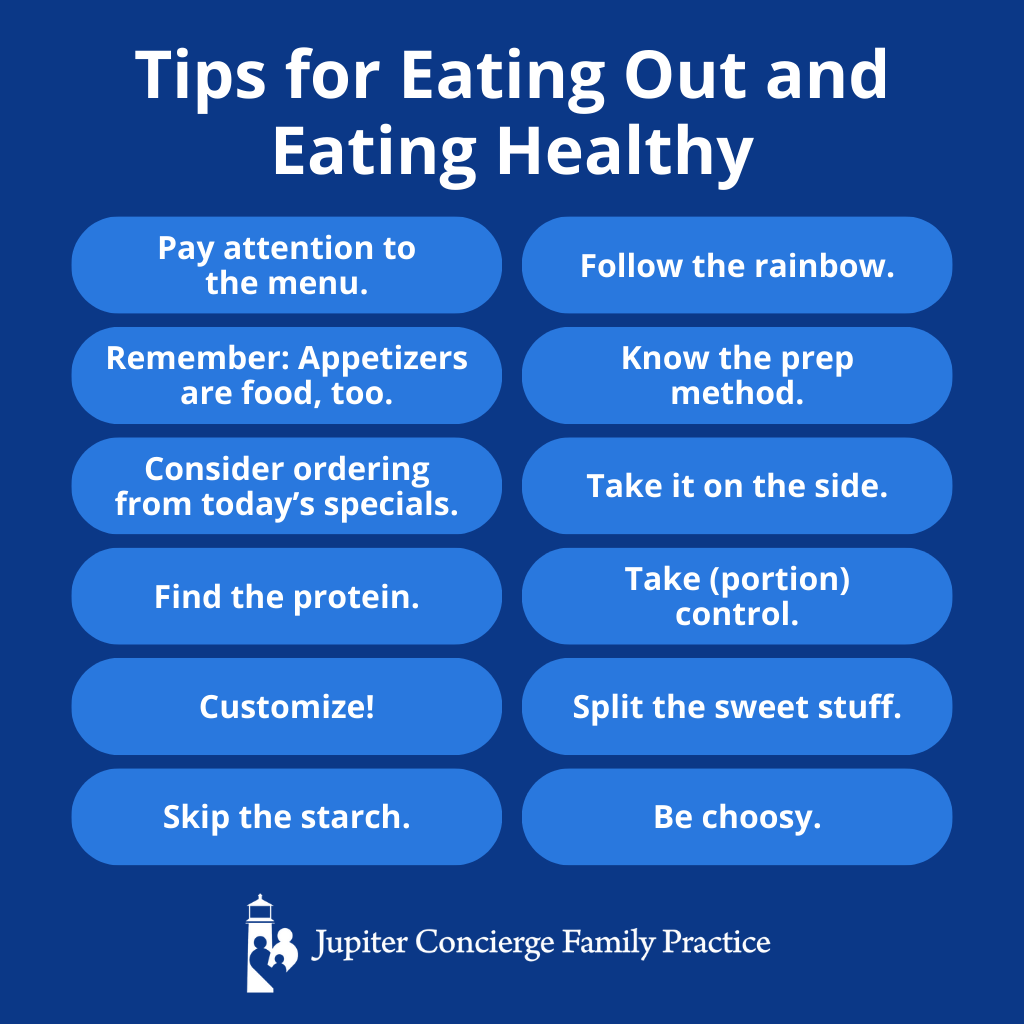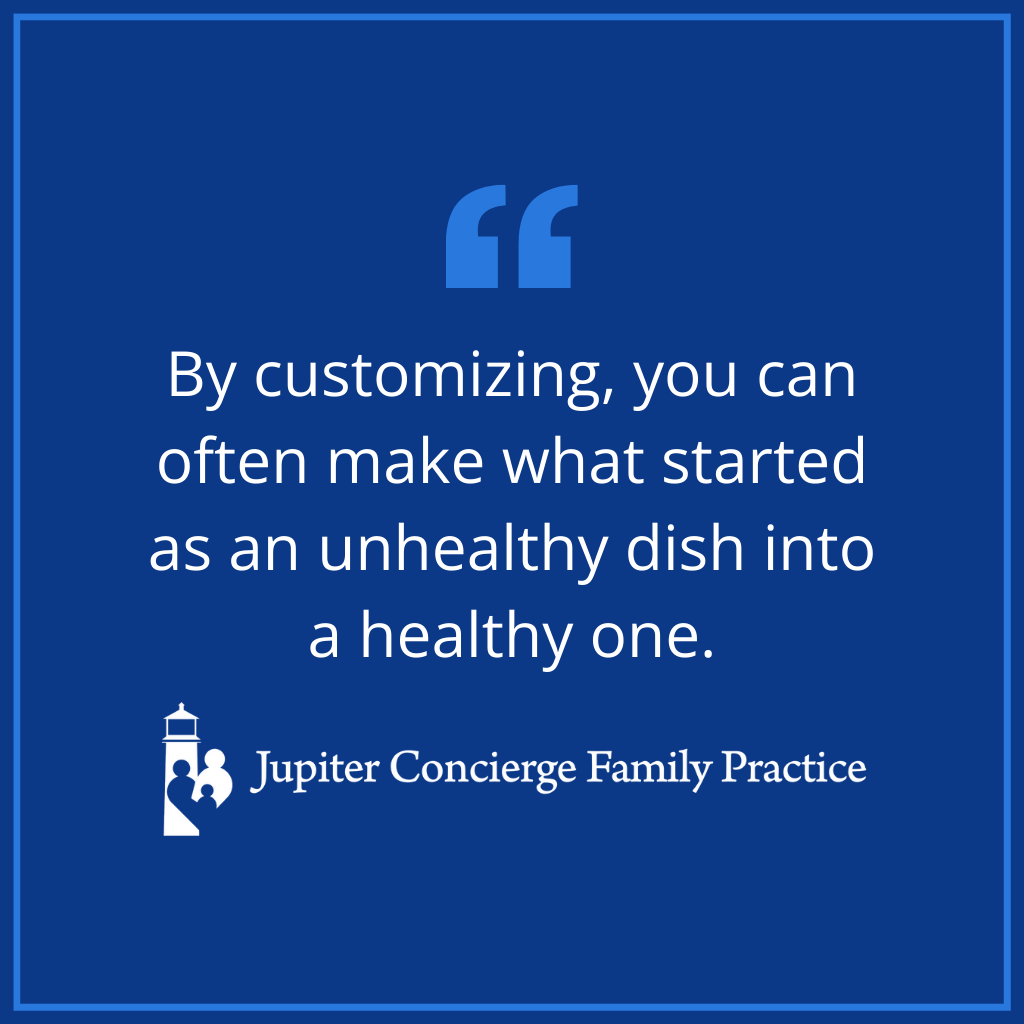
Eating well is one of the most impactful things you can do to achieve vibrant health. Easy to state, hard to do — especially in our modern world.
I’ve written a lot on this blog about how to eat well, especially by shopping strategically at the grocery store. But not everyone wants to cook, has time to cook, or lives with someone who wants to cook for them. And part of a healthy lifestyle also includes getting out and socializing. This brings me to today’s topic: how to eat out and eat healthy at the same time.
There are various reasons people choose to eat out: convenience, celebrations, socializing, necessity, etc. Whatever your motivation, taking a bit of time when selecting from the menu is a powerful way to make a healthy choice. Remember, every healthy choice helps build a healthy habit.
The Hard Truth About Eating Out
There are many reasons why it can be difficult to order healthy food in a restaurant. One big reason is the unknown ingredients and quality of the ingredients. Most restaurants get their ingredients off their distributors’ truck. For food to be in a truck and withstand time and distance, it’s often not fresh, chock-full of preservatives, or a combination of both.
Another reason it’s challenging to eat healthfully at a restaurant is that restaurants cater to your taste buds, not your health. They want to make delicious foods to bring you back again and again. This often means excess sugar, salt, and/or fats to enhance taste.
A third reason is more of an internal matter. When we go out to eat, we often feel deserving of a treat. That’s fair and fine. Splurging makes celebratory and social sense — in moderation. It’s when eating out becomes frequent that we can no longer afford to “treat ourselves” each time. Keeping your urge to splurge in check is a great way to eat out without doing much bodily (or financial) damage.

Tips for Eating Out and Eating Healthy
So, how can we manage these tricky truths of eating out? Here are my 12 top tips for eating out and eating healthy:
1. Pay attention to the menu.
When you look at a menu, pause your conversation and devote your full attention to its offerings. Often, menus have symbols delineating heart healthy, vegetarian, vegan, or low-salt items. Sometimes they even list calories and ingredients. Pay close attention to the information available. Consider what isn’t said. And if you have a question about ingredients, ask.
2. Remember: Appetizers are food, too.
The appetizer can fall into a strange realm of food that we trick ourselves into believing “doesn’t count.” It does.
Factor any appetizers into your overall dining plan, and make sure your appetizer isn’t just empty (or unhealthy) calories. For example, eating tortilla soup at a Mexican restaurant is a smart choice, but not if you eat a bunch of deep-fried chips beforehand.
On the other hand, if you order a healthy appetizer and eat it slowly, you’ll be more full and less likely to finish your main course. This isn’t a bad thing (as long as you don’t stuff yourself). Simply take your leftovers home for lunch tomorrow.
3. Consider ordering from today’s specials.
Read over the day’s specials. When the cook cares about the food, it’ll come out better. These are often the freshest items on the menu as well.
4. Find the protein.
Protein is a critical component of a healthy meal. In a complicated description of a dish, be sure to find the protein source. If there isn’t a protein, add one. In many restaurants, for example, you can add shrimp, chicken, salmon, or steak to pasta or salad.
5. Customize!
Don’t be afraid to give instructions. For example, ask for dressing or sauce on the side so you can put only what you need on your food. Ask to have your steak grilled without butter; ask for no extra salt on your dish; have them leave off the cheese. By customizing, you can often turn what started as an unhealthy dish into a healthy one (see tip #6!).
6. Skip the starch.
A nice trick to increase your nutrients and lower your glycemic index is to skip the starch. Replace potatoes, for example, with a house salad or a side of cooked greens.
7. Follow the rainbow.
Diversity of color indicates diversity of nutrients. Remember our chart about phytonutrients, and search for a colorful meal.
8. Know the prep method.
Food preparation can make healthy food bad for you — e.g., breading fish in white flour and frying it in low-quality oil — but it cannot make unhealthy food good for you. Trash is trash, whether it’s baked or fried.
Slow-cooked food is best. Fried, charred, grilled, and caramelized food preparations degrade nutritive quality and introduce carcinogens.
9. Take it on the side.
Similar to #5 (customize!), taking sauces and dressings on the side allows you to control or eliminate fatty, salty, or sugary concoctions. For example, cheese can ruin the healthiness of broccoli, and salad dressings can be needlessly sweet.
10. Take (portion) control.
Restaurant portions can be notoriously high. Cut down on the likelihood of overeating by taking half your meal home. The bonus of this method is that you save time and money the next day because your lunch is already prepared and paid for!
11. Split the sweet stuff.
Dessert can be fine in moderation. In fact, a little something sweet after a meal can even help with digestion. That said, dessert should never be used to fill you up. To help curb the desire to eat the whole thing, either share your dessert with a companion or bring half of it home. (And don’t eat it the same night!)
12. Be choosy.
Many restaurants feature local and/or organically produced dairy, meats, and vegetables. Whenever you can, opt for these types of restaurants. This will mean higher-quality ingredients, fresher foods, supporting your local food economy, and, in most cases, a tastier, healthier meal.
 Conclusion
Conclusion
Eating out doesn’t have to mean throwing out good habits or buying yourself a stomachache. Following the above tips for eating out healthy can make an enjoyable meal more wholesome — and longer lasting.

Dr. David Rosenberg
Dr. Rosenberg is a board-certified Family Physician. He received his medical degree from the University of Miami in 1988 and completed his residency in Family Medicine at The Washington Hospital in Washington, Pennsylvania in 1991. After practicing Emergency Medicine at Palm Beach Gardens Medical Center for two years, he started private practice in Jupiter, in 1993. He is an avid baseball fan and Beatles fanatic, since he was 8 years old. He has been married to his wife, Mary, since 1985 and has three grown children.
David completed additional studies at Mercer University, Macon, Georgia and obtained a BS in Chemistry in 1983.
“My interests include tennis, snow skiing, Pilates and self-development.”

Subscribe to our Newsletter!
Receive latest blog posts, health tips, and exclusive offers from Jupiter Concierge Family Practice straight to your inbox.
